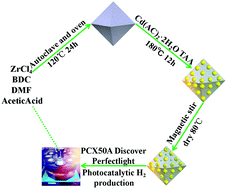Effective electron–hole separation over a controllably constructed WP/UiO-66/CdS heterojunction to achieve efficiently improved visible-light-driven photocatalytic hydrogen evolution
Abstract
The photocatalytic decomposition of water to produce hydrogen is an important strategy to effectively utilize solar energy and solve the energy crisis. In this study, a highly efficient WP-nanoparticle-modified composite catalyst was successfully prepared. WP nanoparticles have been used as an efficient and acid-stable co-catalyst for the HER owing to their specific electronic structure, metalloid characteristics and catalytic activity. On the one hand, the octahedral spatial structure of UiO-66 not only provides attachment space for CdS and WP nanoparticles, but also effectively reduces the particle size and increases the dispersion of CdS and WP nanoparticles. On the other hand, the potential difference and the matching energy band positions of UiO-66 and CdS provide a feasible thermodynamic path for the transmission of photogenerated electrons. The intimate contact between the abovementioned three compounds resulted in a strong synergistic effect, which improved the efficiency of the photocatalytic H2 production. Under visible-light irradiation, the maximum H2 production in 5 h over the [UiO-66@CdS/WP (10 wt%)] photocatalyst was 395 μmol, which was 26.33 times that of pure CdS. The physical and chemical information of the samples could be obtained through XRD, SEM, TEM, XPS, BET and UV-vis DRS characterizations. Furthermore, based on the photoluminescence spectra, photoelectrochemical experiments and Mott–Schottky curves, we could reasonably explain the separation and transfer mechanisms of the photogenerated electrons and holes. The lower recombination rate of charge, enhanced intensity of light absorption, a short fluorescence lifetime (2.11 ns), a faster electron injection rate (KET = 2.32 × 108 s−1), a larger efficiency of electron injection (ηinj = 49.1%), high photocurrent response, and smaller charge transfer resistance accelerate the efficient separation and transfer of spatial charges, finally enhancing the photocatalytic performance.

- This article is part of the themed collection: 2019 PCCP HOT Articles


 Please wait while we load your content...
Please wait while we load your content...